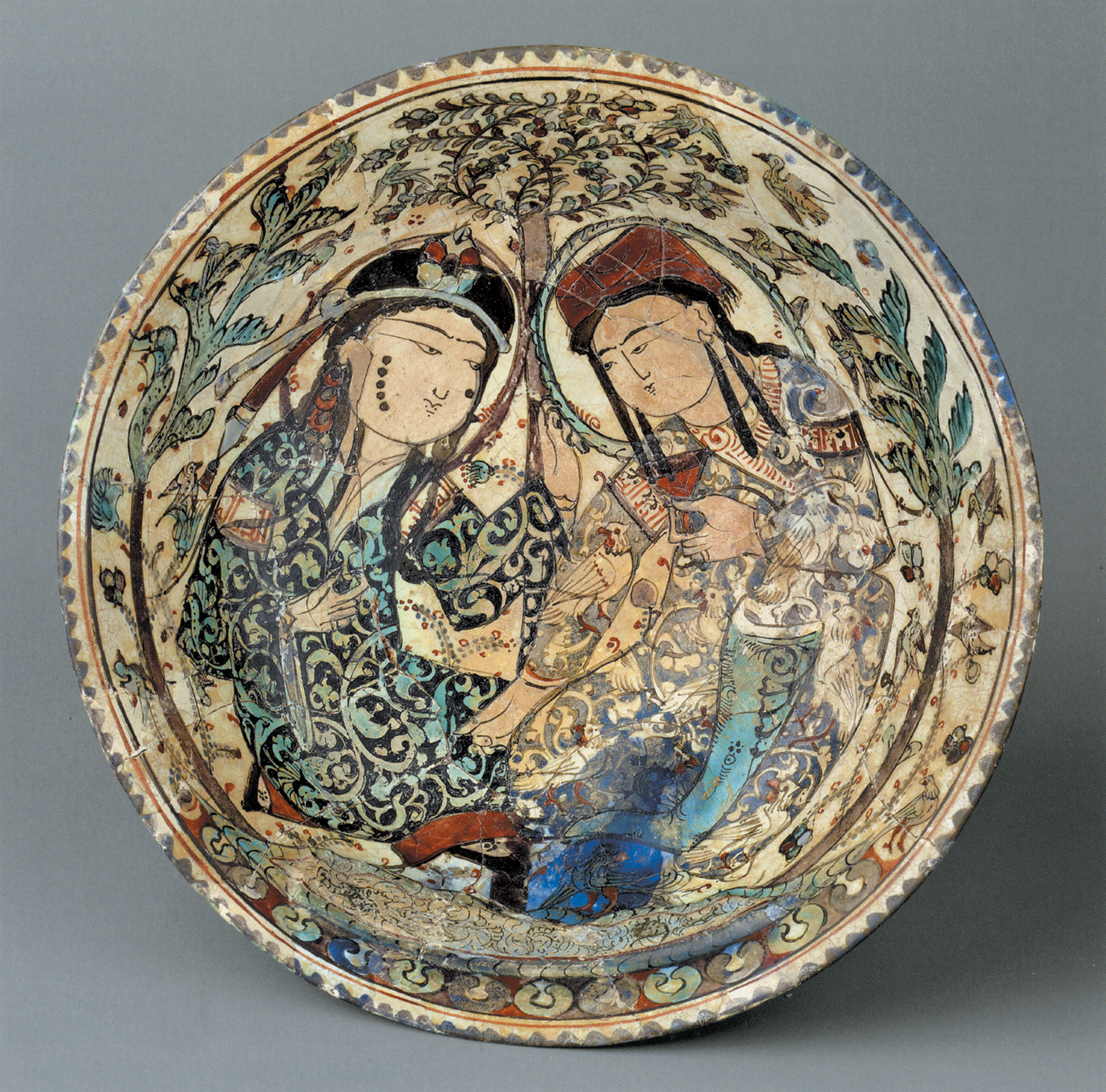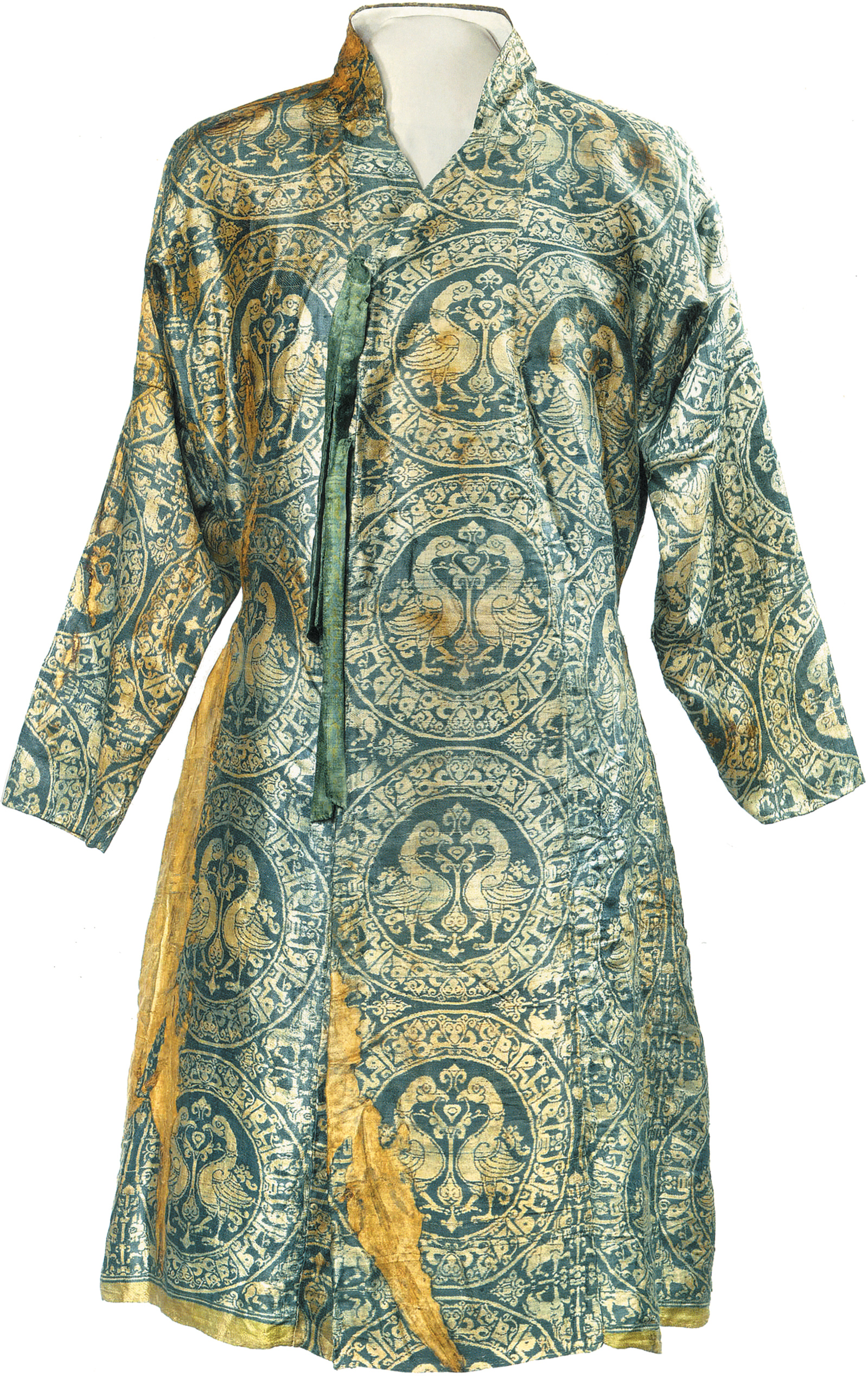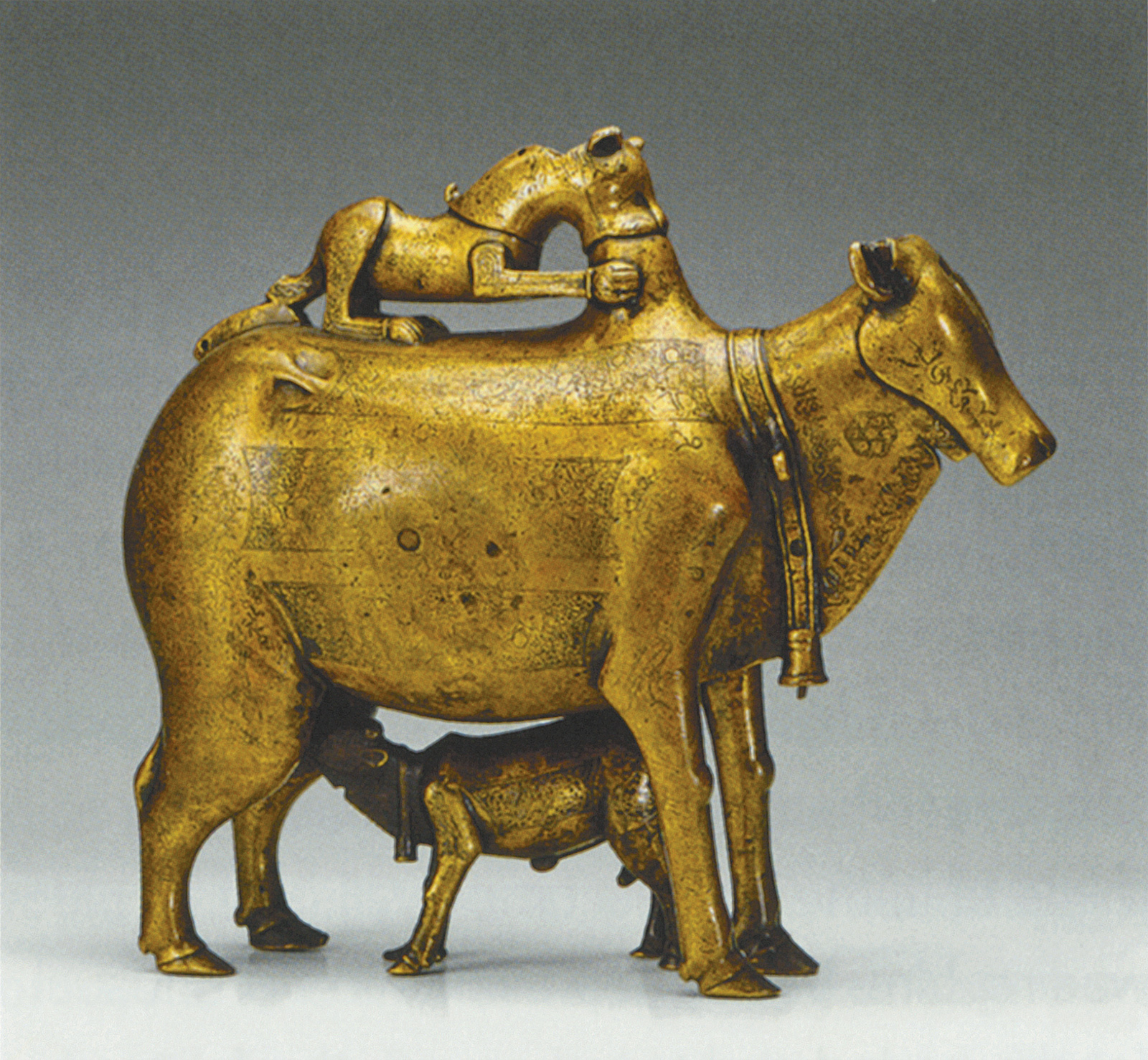We have every reason to be grateful to the Metropolitan Museum of Art for the way its curators have been presenting major exhibitions on hitherto neglected periods and societies. They do not only put Golden Ages on show. They also give careful attention to baffling moments of transformation—such as the great transition between Christianity and Islam in the late antique Middle East or the little-known opening phases of the spread of Hinduism and Buddhism in Southeast Asia.* Such exhibitions are historiographical events of the first order. Temptingly entitled “Court and Cosmos,” the exhibition of the art of the Seljuq rulers, whose empire reached from Central Asia to the eastern Mediterranean, reveals a world that is largely unfamiliar to us.
Even in Turkey, the Seljuqs, who held power there between 1071 and 1307, are overshadowed by the achievements of later, Ottoman Turks—by the campaigns of Mehmed the Conqueror (r. 1451–1481) and by the splendid architecture of Suleyman the Magnificent (r. 1520–1566). To appreciate Seljuq monuments, we have to leave Istanbul, dominated by famous Ottoman mosques, and head eastward into lesser-known corners of Anatolia. Who would expect to find, at the end of a highland valley where beekeepers from the Black Sea still congregate to feed their swarms on sweet mountain thyme, the exquisite mosque and hospital of Divriǧi, built by a Seljuq emir in 1228–1229? Its intricate medallions, carved in golden stone, are as refined and sumptuous as Spanish plateresque. The water channels that run across the floors of the hospital were deliberately carved so as to make the flowing water gurgle with exactly the right tone and rhythm to soothe the strained nerves of the mentally ill, according to a theory of musical therapy that went back to the ancient Greeks.
Seljuq art is full of such surprises. But they do not come easily. The very refinement of Seljuq art renders it opaque to us. The present exhibition has gathered together the best of the best. Brass and silver sparkle under skillfully placed lights. Stucco work comes alive through the play of shadow and light. Ceramics glow with luster or arrest our eyes with unexpected tones and textures. Great robes are spread out as if taken straight from the loom.
But the meaning and uses of many of these objects are hard to grasp. Faced by so much beauty, we must constantly remind ourselves that we are not walking through a splendid jeweler’s store. These objects once lived. They had a part in solemn ceremonies. They conjured up images of the good life. Many are covered in inscriptions in Arabic and Persian that only few of us can decipher. Even their geographical placing is puzzling to us. The Seljuqs are usually associated with Turkey. But as we consult the handsome map on pages 34 and 35 of the catalog, we realize that Seljuq art and architecture were truly international. Seljuq monuments are scattered (in a manner that ignores modern national boundaries) in a great arc from Samarkand to western Turkey. Furthermore, these beautiful objects were the products of artists and craftsmen whose largely anonymous labors hint at layers of the population from whose skilled hands the splendors of the Great Age of the Seljuks emerged.
To understand the Seljuks, we must begin with Central Asia. In the opening chapter of his two-volume History of Persia, published in 1915, Sir Percy Sykes described how he had scrambled up the peak of Kalat-i-Nadiri (on the extreme northeastern frontier of modern Iran), to be greeted by an awesome view:
From the crest I looked across the yellow plain, stretching northwards in level monotony, and was struck by its immensity; for I realized that it stretched as far as the tundra and the distant Arctic Ocean, with no intervening mountains.
Sir Percy, and many others before him, had looked with ill-disguised disquiet at this immense, flat plain. For it was the corridor down which the nomad world of Central Asia had often reached out to touch the settled lands that lay along its southern edge—the fertile plain of the Ganges in northern India, the plateau of Iran, the hillsides of northern Mesopotamia (now northern Iraq), and the rolling uplands of what has become modern Turkey. This was the land of the Turks. It was from it that the descendants of a nomad chief called Seljuq, who had converted to Islam, emerged around 1035 AD, to the dismay of all civilized persons.
The civilized world was right to be dismayed. In 1055 the Seljuqs entered Baghdad and humiliated the caliph—the representative of the proud world empire of the Arabs, thereby (in the opinion of many) bringing to an end the Golden Age of Islam. In 1071, they humiliated yet another ancient empire by defeating the Byzantines at Manzikert, thereby opening up the plains of Anatolia to the Turkmen nomads and their vast herds.
Advertisement
Although they had long proved to be sophisticated politicians whose skills were essential for the running of a Central Asian economy that reached across Eurasia, linking China to the Middle East, the nomadic Turks were still regarded as unreconstructed barbarians. In the late eighth century, they began to enter the Islamic empire as professional soldiers. Like security contractors in a failing state, bands of Turks began to take over the increasingly fragmented eastern territories nominally ruled by the caliph of Baghdad. Already around 900, a bitter Arab poet described the Turkish troops stationed in Baghdad:
There is no joy in going out.
Whom do I meet when I look around? Apes riding on saddles.
But these Turks, at least, had shed their more obtrusive Central Asian characteristics on joining the military. Not so the sons of Seljuq. When Tughril, “the Hawk,” entered Nishapur (in northeastern Iran) in 1037, he still wore the great felt boots of a nomad chieftain. His mustache was so large that its ends had to be tied behind his head when he went out hunting with bow and arrow. (One meets such a figure in the exhibition: the rough stone carving—mustache and all—of a tribal ancestor found in Turkmenistan.)
“The Hawk” also brought his sheep. A nomad army of three thousand men would be accompanied by herds of up to 300,000 sheep. Driven by bellicose Turkmen, these great herds began to move into the empty spaces of Asia Minor, the Caucasus, and northern Iran. As a result, from the plateau of Anatolia, through Iran to western Afghanistan, the countryside slowly settled down to breathe with a Central Asian rhythm, marked by the seasonal passing of great herds. This silent northward turning of the Middle East toward Central Asia was one of the unseen consequences of the rise of the Seljuqs. It marked a new chapter in the history of Eurasia.
This sudden opening of horizons toward Central Asia in the east was not the only “barbarian” invasion to occur at this time. In 1099, the Frankish Crusaders reached Jerusalem and established a Christian kingdom in the Holy Land. Much as the Turks had infiltrated the northeastern reaches of the Middle East from Central Asia, so the Crusaders infiltrated the eastern shoreline of the Mediterranean from the west. Like the Turks, they were warriors. Like the Turks, they looked down from the walls of castles and of fortified citadels on populations with whom they had little or nothing in common.
Crusaders and Turks are often presented as Christian “bearers of the Cross” locked in resolute struggle with Muslim “holy warriors”—with the famous ghazis. At the time, however, both groups of barbarians were viewed similarly by the settled populations over whom they fought. To cultivated Arabs in Syria and Egypt, to cultivated Byzantine Christians, and to the large Christian populations in the Islamic world, both Turks and Crusaders were equally fierce, equally uneducated, and equally filthy in their personal habits. The Seljuqs, at least, were Muslims. But they seemed unlikely candidates for a Great Age.
Still, this Great Age emerged after all. In order to understand how it did so, we must begin with geography. Splendid images of the landscapes of the Seljuk world are projected, in slow succession, on the back wall of the exhibition. Part of the story of the Great Age of the Seljuqs lies in the changing relations between these different landscapes through the joining of two worlds: the world of Central Asia and that of the high plateau that continues without a break from west to east, from western Turkey, through Iran, to Afghanistan and the Hindu Kush.
This plateau corridor was buzzing in Seljuq times with the passage of persons of high skill—men of learning, holy men, and craftsmen. Take one example, known to most of us—the great Sufi mystic Jalal al-Din Rûmi (1207–1273). Jalal al-Din was known as “Rûmi,” “the Roman,” because he had settled in Konya (ancient Iconium), the Seljuq court established in the former territories of “Rûm”—of the Eastern Roman, Byzantine empire. But Jalal al-Din had originally come from over 1,800 miles to the east, from Balkh in what is now northwestern Afghanistan. He came to a remarkably open society, perched on the frontier between Christianity and Islam.
He settled down with a Greek wife. Snatches of Byzantine Greek (written in Arabic script) appear in his poems. He thrilled to new horizons. The insistent beat of the hammers of the craftsmen in the bazaar of Konya made him dance in ecstasy down the street; the rhythmic tinkling of the hammers merged, in his soul, to echo the “watermills of the gardens of Meram”—the beautiful Seljuq gardens outside Konya that were an image of Paradise. In so open and so busy a world, one could be a person of many identities:
Advertisement
What is to be done, O Muslims? For I do not recognize myself.
I am neither Christian, nor Jew, nor Zoroastrian, nor Muslim.
I am not of the East, nor of the West, nor of the land, nor of the sea.
But Jalal al-Din Rûmi, for all his genius, was only one of a great many. As a result of the Seljuq conquests, Islam had to face the task of absorbing entire new populations. The Sufis were the Franciscans of the Turks—they were popular preachers to barely Islamized congregations. It is a remarkable chronological coincidence that one of the first poets to write mystic songs in Turkish, Yünüs Emre (1238–1320), was an exact contemporary of Jacopone da Todi (1230–1306), whose Italian Laude (Praises of Christ) turned Franciscan piety into folk songs. In the same way, Yünüs’s poems, with their haunting refrains, such as “Look what love has made of me,” represented the opening up to a wider audience of a language of intense religious fervor previously limited to Arabic and Persian.
In this diverse world, Christianity had by no means sunk from view. In the upland valleys of what is now eastern Turkey, great Christian monasteries still produced spectacular manuscripts, written in a firm Syriac script that had not changed since the days of the early church. Some of the most splendid works of silver-inlaid brass produced in Mosul (in northern Iraq) were decorated with scenes from the life of Christ and with rows of venerable standing figures. They appear beside signs of the zodiac.
It is a strange juxtaposition. Was it driven, perhaps, by the need for double protection both by favorable stars and by the Christian saints? In the same way, Turkish mothers in Anatolia continued to have their Muslim babies baptized by a Christian priest just in case: “lest they smell like dogs.” Even the Seljuq sultans of Konya were men of multiple identities. Many had been brought up by Christian mothers. One of them, Kaykhusraw I, was able to insult his opponent, the Byzantine emperor himself, by calling him “Shorty” in good Byzantine Greek.
The political fragmentation that followed the lightning conquests of the Seljuqs has often been regretted by modern scholars. But it had an unexpected consequence. It ensured that small principalities (ruled by descendants or clients of the Seljuqs) were scattered across the northern Middle East like a galaxy of pulsating stars. As in Renaissance Italy, every ruler (from minor rulers, such as the emir of Divriǧi, to the grand imperial lords of Isfahan and Samarkand) had to maintain a splendid court in constant competition with his neighbors. For the largely anonymous artists and craftsmen of the cities—like those in the bazaar of Konya—princely patronage was crucial. Much of the work in metal, ceramic, stucco, and textiles that dazzles us in this exhibition was focused both on the ruler and his court and also around this brilliant human group, on the mighty cosmos that engulfed them in a web of occult influences. Seljuq art was, indeed, an art of “Court and Cosmos.” Let us see what this means.
We are looking at objects that were created to express the splendor of the ruler. They derived their meaning from the ceremonies of his court. The great inscribed bowls would be filled with water poured from precious ewers in which the guests washed their hands at banquets. The splendid robes were distributed as signs of rank on high occasions. The exquisite trays would have carried sweetmeats or—better still—precious gifts. Brass and inlaid silver would have danced in the flickering light of great candlesticks. Incense burners in the form of lions or birds of prey would fill the air with magical, energizing scents. When peering at these, we are not looking at mere objects. We are looking at the attributes of a prince in his glory. How was that glory best expressed? By untroubled joy.
In Seljuq circles, as previously in ancient Iran, the notion of razm u bazm—warfare and feasting—carried a heavy charge of meaning. This involved the solemn alternation of war and peace. The fully public explosion of manly energy associated with the hunt—and a fortiori with war—was to be followed by solemn, secluded banqueting accompanied (even in a Muslim court) by heavy drinking. This meant much more than relaxing after the chase. It was a ritual of peace. The sultan was supposed to relax totally because his victories had won him and his entourage total peace. All enemies defeated, he was at his most kingly when most at his leisure.
As we enter the exhibition, we are first met with the face of war—two large soldiers stand with their hands on long swords. But across the way, we immediately see the face of peace on a carefully reconstructed fragment of stucco work from a palace wall. The sultan sits upright at the very center, balancing a wine cup in his hands. On either side of him, courtiers carry the emblems of peace—a drinking cup, a ewer, a songbird, and a rose. They are “moon-faced”: their rounded features (which to the modern eye make them seem like Chinese figurines) radiate the total serenity of youth at its peak. They stand against a strongly patterned floral background as if in a garden in full bloom. For we must remember that the cities where the Seljuqs resided were surrounded by splendid gardens. It was in the quiet of these gardens—and not in the narrow streets or in the high citadel of the town—that Seljuq rulers, used to a life in the tents, felt most at their ease.
A sultan at his rest was more than a successful ruler. He was an avatar. His moment of peace brought back the glories of the kings of old. For the Seljuqs were the direct heirs of an enrichment of the imagination that was as profound (in the Middle Eastern world) as was the emergence of the Arthurian legends in twelfth- and thirteenth-century Western Europe. In 1010—that is, only two decades before the rise of the Seljuqs and in the same frontier zone between Central Asia and Iran as that first conquered by the Turks—Abu-l-Qasim Firdawsi completed his great Shahnama, his Book of the Kings. This vast epic, written in pure, spellbinding Persian verse, recounted the stories of the kings of Iran from the beginning of time to the end of the Sasanian Empire in the seventh century AD. In this exhibition we can even see leaves from the first surviving copy of the Shahnama, made either in Iran or in Anatolia in 1217 AD. To read it (or, more often, to hear it recited) was not only to be thrilled by tales from a distant, magical age. It was a guide to kingship—almost a constitution in verse—for the many rulers of the Seljuq age.
Like the chivalrous Arthurian legends in the Catholic West, the Shahnama added a haunting extra dimension to the accustomed worldview of its readers. For contemporary Muslims here were kings larger than life from a world before Islam. They were more bellicose in war and in the hunt, more full of gusto, and—above all—more just in their rule than the kings of modern times. Islam was believed to have brought the truth in religious matters (much as Catholicism was believed to have brought the true faith to the knights of Europe). But kingship was a different matter. Kingship had always been there. Kingship was the basic institution on which all human society had been founded. A world without kings was a world reduced to anarchy. The maintenance of kingship, therefore, was a duty for everyone irrespective of their religion.
To be a good king was to sink oneself into a deep, primordial past, shared by all human beings since the beginning of time. Only kings from a dream time before Islam—like vast Jurassic beasts—could act as models for the present. Not surprisingly, the most open and in many ways the most adventurous line of Seljuqs—the Seljuq sultans of Rûm at Konya—bore the names of the earliest kings of Iran taken from the Shahnama of Firdawsi: Kaykhusraw, Kaykubad, Kaykâ’ûs.
Altogether, the Seljuq courts were unusual for their sense of peering down a deep well into a long-forgotten pre-Muslim past. At the bottom of this well, beside the legendary rulers of Iran, stood Alexander the Great. Very different from the Macedonian prodigy of classical times, Alexander as imagined in the Islamic world (as Iskander) was a primal monarch in Persian style. He was a world ruler as a world ruler should be. He was careful to take good advice. Alexander, as we know, had maintained relations with the great Greek philosopher Aristotle. As Aristu, Aristotle the Greek philosopher mutated into a wise vizir in the Persian manner; even into a teacher of the magical arts. Aristu was supposed to have initiated his royal charge, Iskander, into magical practices contained in a book called the Secret of Secrets. This book (which was, in fact, probably written in the early ninth century) discussed the art of making talismans, astrology, and the physical properties of plants and stones.
In a rare bowl of cloisonné enamel, Alexander is shown ascending into heaven in a chariot carried by griffins. It was made for a twelfth-century ruler at Hisn Kayfa (modern Hasankeyf). At Hisn Kayfa, the road passes the ruins of a Seljuq bridge over the Tigris, having left behind a flat Mesopotamian plain, covered with the ruins of cities from biblical times, to come out on to a very different landscape of rolling hillsides, like gigantic folds of felt, on the high plateau that was the main corridor of the Seljuq world. The memory of Alexander, world ruler and magician, would have lingered at a court such as this, which lay at one of the crossroads of the Middle East.
Last but not least, the ruler was the favorite of heaven. His peaceful rule echoed the order of the cosmos. His vicissitudes betrayed nothing less than the stealthy movements of the planets as they moved through the signs of the zodiac like gaming pieces on a great chessboard. Some of the most beautiful pieces in “Court and Cosmos” are covered with zodiacal signs. They are fairy-tale adaptations to a medieval, Middle Eastern taste of the conventional images used by classical Greeks and Romans millennia before. They were considered to be heavy with good fortune.
Astrology was a serious matter. For to look up at the stars was not only to search out one’s own destiny and to make contact with the currents of good fortune revealed in their complex movements. In a long Persian tradition that linked astrology to statecraft, it was to detect, also, the fateful signs of the wavering of a dynasty or, on an even larger scale, of some dark conjunction that might indicate the end of an age.
No wonder then that the astrolabes and stellar globes shown in this exhibition should impress us with their scientific precision. They were not used for observational astronomy alone. Rather, astronomical observations of the most accurate kind were part of a formidable technology designed to scan the human future written in the sky. Astrology provided a language of risk—not unlike the sophisticated predictions provided by modern economic pundits—that took account of events that lay beyond human control, of the wider structures that shaped human action, and of hidden turnings in the fate of whole societies such as preoccupied (and for good reason) the elites of the taut but brilliant network of nomad chiefs turned statesmen that made up the Seljuq world.
-
*
See the exhibition catalogs Byzantium and Islam: Age of Transition, edited by Helen C. Evans and Brandie Ratliff (Metropolitan Museum of Art, 2012) and reviewed by me in these pages, May 10, 2012; and Lost Kingdoms: Hindu-Buddhist Sculpture of Early Southeast Asia, edited by John Guy (Metropolitan Museum of Art, 2014), reviewed by William Dalrymple in these pages, May 21, 2015. ↩






